Faux Finishes
- Historical
Examples
Historically, the most commonly imitated
finishes were various kinds of marbles and woods. In the 17th
century for example, master artists were commissioned to decorate
the Versailles Palace. Skilful gilding, marbleizing, and "trompe
l'oeil" effects on mouldings etc transformed palaces and
other residences of the European aristocracy into truly magnificent
works of art.
Faux finish techniques continued to be used
in the 19th century, when decorative painting reached glorious
heights in France and most of Europe. At this time, the burgeoning
middle and upper classes also began decorating their homes lavishly,
rivalling the elegance that was once accessible only by the noble
classes. Elaborate faux finish techniques were employed to achieve
the luxurious look of marble and expensive woods, stonework and
various other kinds of ornamentation both textural and architectural.
The use of techniques to imitate marble
and woodgraining as well as inlays of various woods and other
materials like mother-of-pearl etc filtered into some of the
traditional folk arts like Hindeloopen, Bauernmalerei, Rosemaling and Canalboat
Painting as simple decorative effects meant to enhance their
painted designs. A marble effect, for example, was commonly
painted on panels of painted furniture or other objects very
simply using the colors picked from the painted design.
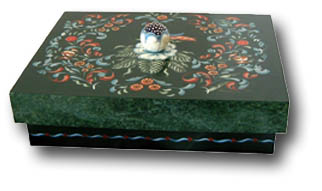
The sides of the cover of this Hindeloopen document box were given
a faux green marble effect.
Woodgraining
was done to simulate wood grain patterns with paint and was
used in many different styles of traditional decorative painting.
Oak graining, for example, was used in Canalboat Painting,
and
rosewood graining was very popular in early American folk painting.
In Intarsian Painting, various
woodgrains were imitated to create a wood inlay effect on furniture
during
the Beidermeier Era.
Many old pieces
of painted decoration found have been deliberately aged using
various methods which
we know today as "flaking paint" or "crackle" effect.
This is a form of faux finish which is aimed at tricking the
viewer into thinking that a painted object is older than it looks,
even an heirloom! This effect of fracturing or breaking of the
background color and the painted image was also quite common among French tole
pieces.
Uses
of Faux Finishes in Today's Decorative Painting
Faux finishes are used in
a variety of ways in decorative painting today:
-
by itself for a complete
project, ideal to get a "masculine" look
-
as a background before
painting a design
-
as a border for a painted
design
-
as a complement for
a project e.g. on the insides, bottom or sides of a box
-
using many different
finishes, to create an intarsian project
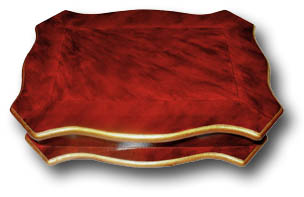
This cigar box was decorated with a faux red toroiseshell
effect. The edges of the box were gilded using gold paint. 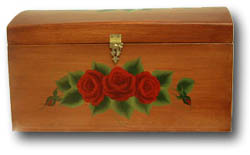
Real wood? This MDF wooden trunk was woodgrained
and then painted with a roses design on all sides.
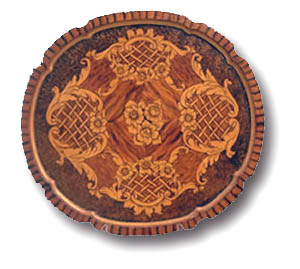
Various woods are imitated in this intarsian painting
project, many European. This tray was a labour of love - painted
with Vicki Nicholson at one of her seminars in Kuala Lumpur.
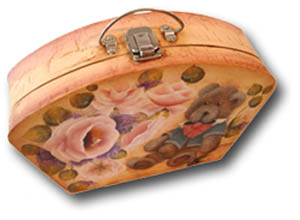
The sides and back of this papier mache box-bag
painted with a teddy and roses design were crackled to give an
old world
look. |